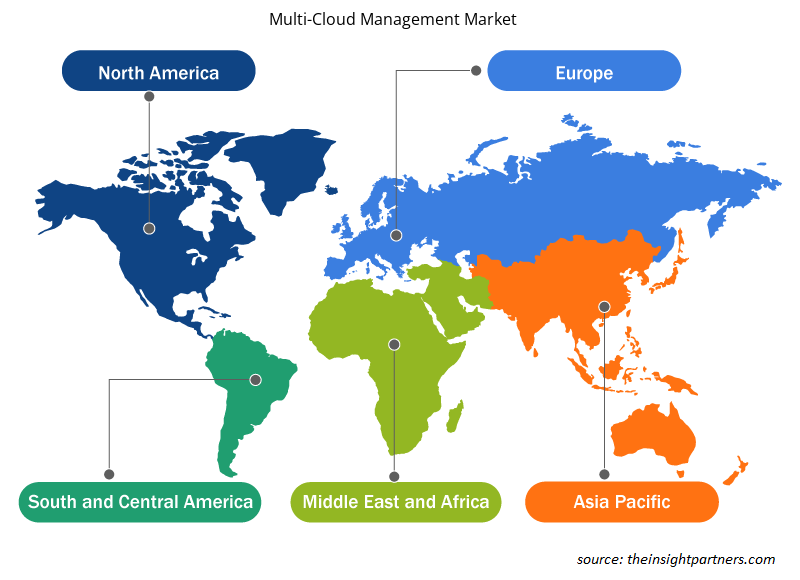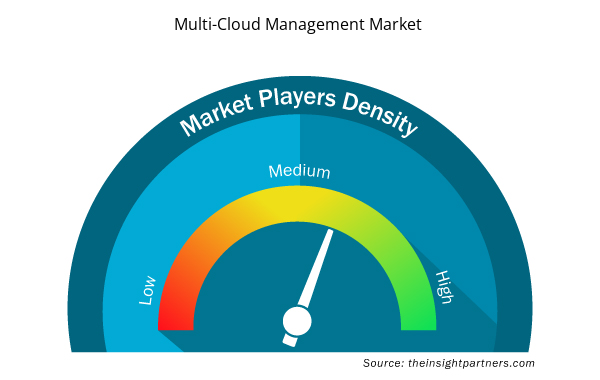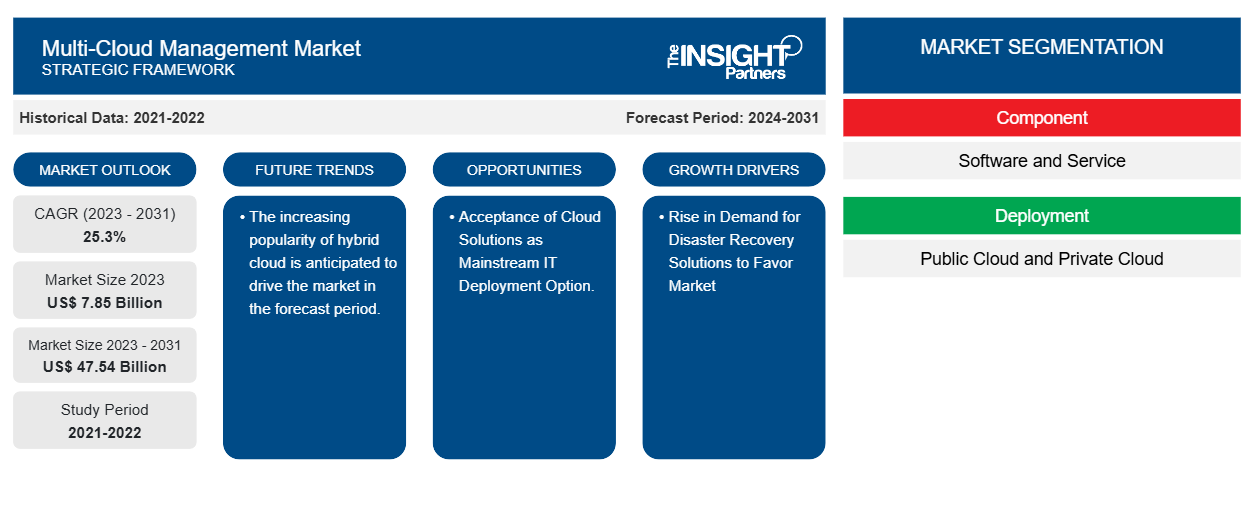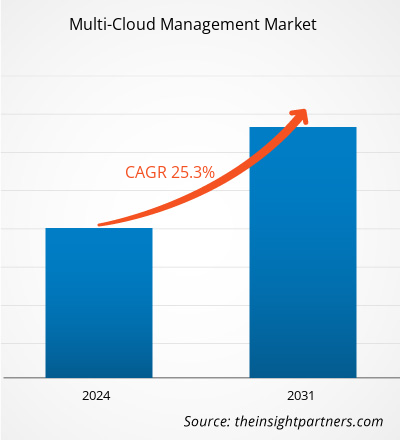Der Markt für Multi-Cloud-Management soll von 7,85 Milliarden US-Dollar im Jahr 2023 auf 47,54 Milliarden US-Dollar im Jahr 2031 anwachsen. Für den Zeitraum 2023–2031 wird ein durchschnittliches jährliches Wachstum von 25,3 % erwartet. Der zunehmende Bedarf, eine Abhängigkeit von einem Anbieter zu vermeiden, ist groß. Eine Abhängigkeit von einem Anbieter bezeichnet eine Situation, in der ein Unternehmen sein Geschäft von seinem aktuellen Anbieter abtreten möchte, dies jedoch aus verschiedenen Gründen nicht tun kann. Dazu zählen die voraussichtlichen Kosten, die Dauer und die Komplexität des Wechsels sowie die steigende Nachfrage nach Lösungen zur Notfallwiederherstellung. Dies dürften die wichtigsten Trends und Treiber für den Multi-Cloud-Management-Markt sein.
Marktanalyse für Multi-Cloud-Management
Der Markt für Multi-Cloud-Management verzeichnet weltweit ein deutliches Wachstum. Dieses Wachstum ist auf die zunehmende Notwendigkeit zurückzuführen, die Abhängigkeit von einem Anbieter zu vermeiden, und auf die steigende Nachfrage nach Lösungen zur Notfallwiederherstellung. Darüber hinaus wird erwartet, dass die wachsende Popularität der Hybrid Cloud, die zunehmende Datengenerierung und die Zunahme von BYOD (Bring Your Device) und CYOD (Choose Your Device) den Markt in den kommenden Jahren antreiben werden.
Marktübersicht für Multi-Cloud-Management
Unter Multi-Cloud-Management versteht man eine Reihe von Tools und Verfahren, die es einem Unternehmen ermöglichen, Anwendungen und Workloads über mehrere öffentliche Clouds hinweg zu sichern und zu überwachen. Eine Multi-Cloud-Management-Lösung ermöglicht es IT-Teams, mehrere Clouds über eine einzige Schnittstelle zu verwalten und unterstützt mehrere Cloud-Plattformen wie Azure und AWS.
Passen Sie diesen Bericht Ihren Anforderungen an
Sie erhalten kostenlos individuelle Anpassungen an jedem Bericht, einschließlich Teilen dieses Berichts oder einer Analyse auf Länderebene, eines Excel-Datenpakets sowie tolle Angebote und Rabatte für Start-ups und Universitäten.
- Holen Sie sich die wichtigsten Markttrends aus diesem Bericht.Dieses KOSTENLOSE Beispiel umfasst eine Datenanalyse von Markttrends bis hin zu Schätzungen und Prognosen.
Treiber und Chancen des Multi-Cloud-Management-Marktes
Steigende Nachfrage nach Disaster Recovery-Lösungen begünstigt den Markt
Disaster Recovery (DR) ist ein entscheidender Aspekt jeder Cloud-Bereitstellung. Laut Statistiken des World Backup Day werden 10 % der Computer jeden Monat von Viren angegriffen und 30 % der Benutzer sichern ihre Daten nie. Darüber hinaus sind Missgeschicke, darunter das Löschen von Daten durch Mitarbeiter, die nicht anderswo gesichert wurden, für 29 % der Katastrophen verantwortlich. Darüber hinaus bieten verschiedene Unternehmen auf dem Markt Lösungen zur Notfallwiederherstellung an. Beispielsweise ermöglicht die Lösung Persistent Multi-Cloud Disaster Recovery Unternehmen, Anwendungsmobilität und Datenschutz ohne Einschränkungen zu erreichen, um die Geschäftsresistenz zu erreichen. IT-Manager können jede Anwendung, jedes Betriebssystem, jeden Container, jede Datenbank, alle Daten usw. in einer Hybrid- und Multi-Cloud-Infrastruktur sicher und schnell schützen.
Akzeptanz von Cloud-Lösungen als gängige Option für die IT-Bereitstellung.
Die Mehrheit der Unternehmen weltweit akzeptiert Cloud-Dienste als praktikables IT-Bereitstellungsmodell. Die am häufigsten genannten Gründe für die Einführung der Cloud sind nach wie vor die Flexibilität und Datensicherheit der Cloud als Bereitstellungsplattform. Viele Unternehmen sind bereits auf einen oder mehrere Cloud-Dienste umgestiegen und haben andere dazu bewegt, die Cloud zu nutzen, um sich einen Wettbewerbsvorteil zu verschaffen. Die Cloud wird derzeit im Rahmen der IT-Strategie eines Unternehmens als glaubwürdiges Bereitstellungsmodell anerkannt. Die Zufriedenheit ist nach wie vor hoch und zwei Drittel der Endbenutzer weltweit, die heute einen Cloud-Dienst nutzen, gehen davon aus, dass sie ihren Einsatz im kommenden Jahr ausweiten werden.
Segmentierungsanalyse des Multi-Cloud-Management-Marktberichts
Wichtige Segmente, die zur Ableitung der Marktanalyse für Multi-Cloud-Management beigetragen haben, sind Komponenten, Bereitstellung, Anwendung und Vertikale.
- Basierend auf den Komponenten ist der Multi-Cloud-Management-Markt in Software und Service unterteilt. Es wird erwartet, dass das Softwaresegment im Prognosezeitraum einen erheblichen Marktanteil halten wird.
- Basierend auf der Bereitstellung wird der Multi-Cloud-Management-Markt in Public Cloud und Private Cloud unterteilt. Es wird erwartet, dass das Public-Cloud-Segment im Prognosezeitraum einen erheblichen Marktanteil halten wird.
- Nach Anwendung ist der Markt in Infrastruktur- und Ressourcenmanagement, Identitäts- und Richtlinienmanagement, Compliance-Management, Messung und Abrechnung sowie Bereitstellung und Lebenszyklusmanagement unterteilt. Das Segment Infrastruktur- und Ressourcenmanagement wird im Prognosezeitraum voraussichtlich einen erheblichen Marktanteil halten.lifecycle management. The infrastructure and resource management segment is anticipated to hold a significant market share in the forecast period.
- Nach Branchen ist der Markt segmentiert in IT und Telekommunikation, BFSI, Regierung, Einzelhandel und Konsumgüter, Reisen und Gastgewerbe, Gesundheitswesen und Biowissenschaften und andere. Das IT- und Telekommunikationssegment dürfte im Prognosezeitraum einen erheblichen Marktanteil halten.BFSI, government, retail and consumer goods, travel and hospitality, healthcare and life science, and others. The IT and telecom segment is anticipated to hold a significant market share in the forecast period.
Multi-Cloud-Management Marktanteilsanalyse nach Geografie
Der geografische Umfang des Marktberichts zum Multi-Cloud-Management ist hauptsächlich in fünf Regionen unterteilt: Nordamerika, Asien-Pazifik, Europa, Naher Osten und Afrika sowie Süd- und Mittelamerika.
Nordamerika dominiert den Markt für Multi-Cloud-Management. Der Anstieg des Multi-Cloud-Management-Marktes in Nordamerika ist hauptsächlich auf einen drastischen Anstieg der Daten, die zunehmende Nutzung von IoT und Cloud-Infrastruktur sowie einen sprunghaften Anstieg des Baus von Rechenzentren zurückzuführen. Cloud Computing ist ein wichtiger Trend in allen Organisationen in Nordamerika. Die Cloud wird für Unternehmen in den USA und Kanada schnell zur neuen Norm. Darüber hinaus zwingt eine starke Betonung von Forschung und Entwicklung in den entwickelten Volkswirtschaften der USA und Kanadas die nordamerikanischen Akteure dazu, technologisch fortschrittliche Lösungen auf den Markt zu bringen. Darüber hinaus gibt es in den USA eine große Anzahl von Akteuren auf dem Multi-Cloud-Management-Markt, die sich zunehmend auf die Entwicklung innovativer Lösungen konzentrieren. All diese Faktoren tragen zum Wachstum des Multi-Cloud-Management-Marktes in der Region bei.IoT and cloud infrastructure, and a surge in data center construction. Cloud computing is a major trend across all organizations in North America. The cloud is fast becoming the new norm for enterprises in the US and Canada. Moreover, a strong emphasis on research and development in the developed economies of the US and Canada is forcing the North American players to bring technologically advanced solutions into the market. In addition, the US has a large number of multi-cloud management market players who have been increasingly focusing on developing innovative solutions. All these factors contribute to the region's growth of the multi-cloud management market.
Regionale Einblicke in den Multi-Cloud-Management-Markt
Die regionalen Trends und Faktoren, die den Multi-Cloud-Management-Markt während des Prognosezeitraums beeinflussen, wurden von den Analysten von Insight Partners ausführlich erläutert. In diesem Abschnitt werden auch die Marktsegmente und die Geografie des Multi-Cloud-Managements in Nordamerika, Europa, im asiatisch-pazifischen Raum, im Nahen Osten und Afrika sowie in Süd- und Mittelamerika erörtert.

- Holen Sie sich regionale Daten zum Multi-Cloud-Management-Markt
Umfang des Marktberichts zur Multi-Cloud-Verwaltung
| Berichtsattribut | Details |
|---|---|
| Marktgröße im Jahr 2023 | 7,85 Milliarden US-Dollar |
| Marktgröße bis 2031 | 47,54 Milliarden US-Dollar |
| Globale CAGR (2023 - 2031) | 25,3 % |
| Historische Daten | 2021-2022 |
| Prognosezeitraum | 2024–2031 |
| Abgedeckte Segmente | Nach Komponente
|
| Abgedeckte Regionen und Länder | Nordamerika
|
| Marktführer und wichtige Unternehmensprofile |
|
Dichte der Marktteilnehmer im Bereich Multi-Cloud-Management: Die Auswirkungen auf die Geschäftsdynamik verstehen
Der Markt für Multi-Cloud-Management wächst rasant, angetrieben durch die steigende Nachfrage der Endnutzer aufgrund von Faktoren wie sich entwickelnden Verbraucherpräferenzen, technologischen Fortschritten und einem größeren Bewusstsein für die Vorteile des Produkts. Mit steigender Nachfrage erweitern Unternehmen ihr Angebot, entwickeln Innovationen, um die Bedürfnisse der Verbraucher zu erfüllen, und nutzen neue Trends, was das Marktwachstum weiter ankurbelt.
Die Marktteilnehmerdichte bezieht sich auf die Verteilung der Firmen oder Unternehmen, die in einem bestimmten Markt oder einer bestimmten Branche tätig sind. Sie gibt an, wie viele Wettbewerber (Marktteilnehmer) in einem bestimmten Marktraum im Verhältnis zu seiner Größe oder seinem gesamten Marktwert präsent sind.
Die wichtigsten auf dem Multi-Cloud-Management-Markt tätigen Unternehmen sind:
- BMC Software; Inc.
- Cisco Systems, Inc.
- Flexera
- Internationale Business Machines Corporation
- Micro Focus International plc
- Zerto Ltd.
Haftungsausschluss : Die oben aufgeführten Unternehmen sind nicht in einer bestimmten Reihenfolge aufgeführt.

- Überblick über die wichtigsten Akteure auf dem Multi-Cloud-Management-Markt
Neuigkeiten und aktuelle Entwicklungen zum Multi-Cloud-Management-Markt
Der Multi-Cloud-Management-Markt wird durch die Erfassung qualitativer und quantitativer Daten nach Primär- und Sekundärforschung bewertet, die wichtige Unternehmensveröffentlichungen, Verbandsdaten und Datenbanken umfasst. Nachfolgend sind einige der Entwicklungen auf dem Multi-Cloud-Management-Markt aufgeführt:
- Oracle und Google Cloud haben eine Partnerschaft angekündigt, die Kunden die Möglichkeit gibt, Oracle Cloud Infrastructure (OCI) und Google Cloud-Technologien zu kombinieren, um ihre Anwendungsmigrationen und -modernisierungen zu beschleunigen. (Quelle: Oracle, Unternehmenswebsite, Juni 2024)
- Verizon Business hat Network as a Service (NaaS) Cloud Management angekündigt, einen neuen Service, der es Unternehmen ermöglicht, Anwendungskomponenten und Netzwerkarchitekturen über mehrere Cloud-Umgebungen hinweg – öffentliche, private und hybride – in einem einheitlichen Online-Portal zu steuern. (Quelle: Verizon, Unternehmenswebsite, Februar 2024)
Abdeckung und Ergebnisse des Multi-Cloud-Management-Marktberichts
Der Bericht „Marktgröße und Prognose für Multi-Cloud-Management (2021–2031)“ bietet eine detaillierte Analyse des Marktes, die die folgenden Bereiche abdeckt:
- Marktgröße und Prognose für Multi-Cloud-Management auf globaler, regionaler und Länderebene für alle abgedeckten wichtigen Marktsegmente.
- Markttrends im Bereich Multi-Cloud-Management sowie Marktdynamik wie treibende Faktoren, Einschränkungen und wichtige Chancen.
- Detaillierte PEST/Porters Five Forces- und SWOT-Analyse.
- Marktanalyse zum Multi-Cloud-Management, die wichtige Markttrends, globale und regionale Rahmenbedingungen, wichtige Akteure, Vorschriften und aktuelle Marktentwicklungen abdeckt.
- Branchenlandschaft und Wettbewerbsanalyse, einschließlich Marktkonzentration, Heatmap-Analyse, prominenten Akteuren und aktuellen Entwicklungen für den Multi-Cloud-Management-Markt.
- Detaillierte Firmenprofile.
- Historische Analyse (2 Jahre), Basisjahr, Prognose (7 Jahre) mit CAGR
- PEST- und SWOT-Analyse
- Marktgröße Wert/Volumen – Global, Regional, Land
- Branche und Wettbewerbsumfeld
- Excel-Datensatz


- Hydrolyzed Collagen Market
- Hummus Market
- Photo Editing Software Market
- Quantitative Structure-Activity Relationship (QSAR) Market
- Formwork System Market
- Resistance Bands Market
- Industrial Valves Market
- Space Situational Awareness (SSA) Market
- Semiconductor Metrology and Inspection Market
- Online Exam Proctoring Market

Report Coverage
Revenue forecast, Company Analysis, Industry landscape, Growth factors, and Trends

Segment Covered
This text is related
to segments covered.

Regional Scope
North America, Europe, Asia Pacific, Middle East & Africa, South & Central America

Country Scope
This text is related
to country scope.
Häufig gestellte Fragen
The expected CAGR of the multi-cloud management market is 25.3%.
The global multi-cloud management market is expected to reach US$ 47.54 billion by 2031.
The increasing popularity of hybrid cloud is anticipated to drive the market in the forecast period.
The key players holding majority shares in the global multi-cloud management market are BMC Software Inc., Cisco Systems, Inc., Flexera, International Business Machines Corporation, Micro Focus International plc, Zerto Ltd., VMware, Inc., Snow Software, Inc., UnityOneCloud, Dynatrace, Inc.
The surge in the need to avoid vendor lock-in and the rise in demand for disaster recovery solutions are some of the factors driving the multi-cloud management market.
North America is anticipated to dominate the multi-cloud management market in 2023.
Trends and growth analysis reports related to Technology, Media and Telecommunications : READ MORE..
The Insight Partners performs research in 4 major stages: Data Collection & Secondary Research, Primary Research, Data Analysis and Data Triangulation & Final Review.
- Data Collection and Secondary Research:
As a market research and consulting firm operating from a decade, we have published and advised several client across the globe. First step for any study will start with an assessment of currently available data and insights from existing reports. Further, historical and current market information is collected from Investor Presentations, Annual Reports, SEC Filings, etc., and other information related to company’s performance and market positioning are gathered from Paid Databases (Factiva, Hoovers, and Reuters) and various other publications available in public domain.
Several associations trade associates, technical forums, institutes, societies and organization are accessed to gain technical as well as market related insights through their publications such as research papers, blogs and press releases related to the studies are referred to get cues about the market. Further, white papers, journals, magazines, and other news articles published in last 3 years are scrutinized and analyzed to understand the current market trends.
- Primary Research:
The primarily interview analysis comprise of data obtained from industry participants interview and answers to survey questions gathered by in-house primary team.
For primary research, interviews are conducted with industry experts/CEOs/Marketing Managers/VPs/Subject Matter Experts from both demand and supply side to get a 360-degree view of the market. The primary team conducts several interviews based on the complexity of the markets to understand the various market trends and dynamics which makes research more credible and precise.
A typical research interview fulfils the following functions:
- Provides first-hand information on the market size, market trends, growth trends, competitive landscape, and outlook
- Validates and strengthens in-house secondary research findings
- Develops the analysis team’s expertise and market understanding
Primary research involves email interactions and telephone interviews for each market, category, segment, and sub-segment across geographies. The participants who typically take part in such a process include, but are not limited to:
- Industry participants: VPs, business development managers, market intelligence managers and national sales managers
- Outside experts: Valuation experts, research analysts and key opinion leaders specializing in the electronics and semiconductor industry.
Below is the breakup of our primary respondents by company, designation, and region:

Once we receive the confirmation from primary research sources or primary respondents, we finalize the base year market estimation and forecast the data as per the macroeconomic and microeconomic factors assessed during data collection.
- Data Analysis:
Once data is validated through both secondary as well as primary respondents, we finalize the market estimations by hypothesis formulation and factor analysis at regional and country level.
- Macro-Economic Factor Analysis:
We analyse macroeconomic indicators such the gross domestic product (GDP), increase in the demand for goods and services across industries, technological advancement, regional economic growth, governmental policies, the influence of COVID-19, PEST analysis, and other aspects. This analysis aids in setting benchmarks for various nations/regions and approximating market splits. Additionally, the general trend of the aforementioned components aid in determining the market's development possibilities.
- Country Level Data:
Various factors that are especially aligned to the country are taken into account to determine the market size for a certain area and country, including the presence of vendors, such as headquarters and offices, the country's GDP, demand patterns, and industry growth. To comprehend the market dynamics for the nation, a number of growth variables, inhibitors, application areas, and current market trends are researched. The aforementioned elements aid in determining the country's overall market's growth potential.
- Company Profile:
The “Table of Contents” is formulated by listing and analyzing more than 25 - 30 companies operating in the market ecosystem across geographies. However, we profile only 10 companies as a standard practice in our syndicate reports. These 10 companies comprise leading, emerging, and regional players. Nonetheless, our analysis is not restricted to the 10 listed companies, we also analyze other companies present in the market to develop a holistic view and understand the prevailing trends. The “Company Profiles” section in the report covers key facts, business description, products & services, financial information, SWOT analysis, and key developments. The financial information presented is extracted from the annual reports and official documents of the publicly listed companies. Upon collecting the information for the sections of respective companies, we verify them via various primary sources and then compile the data in respective company profiles. The company level information helps us in deriving the base number as well as in forecasting the market size.
- Developing Base Number:
Aggregation of sales statistics (2020-2022) and macro-economic factor, and other secondary and primary research insights are utilized to arrive at base number and related market shares for 2022. The data gaps are identified in this step and relevant market data is analyzed, collected from paid primary interviews or databases. On finalizing the base year market size, forecasts are developed on the basis of macro-economic, industry and market growth factors and company level analysis.
- Data Triangulation and Final Review:
The market findings and base year market size calculations are validated from supply as well as demand side. Demand side validations are based on macro-economic factor analysis and benchmarks for respective regions and countries. In case of supply side validations, revenues of major companies are estimated (in case not available) based on industry benchmark, approximate number of employees, product portfolio, and primary interviews revenues are gathered. Further revenue from target product/service segment is assessed to avoid overshooting of market statistics. In case of heavy deviations between supply and demand side values, all thes steps are repeated to achieve synchronization.
We follow an iterative model, wherein we share our research findings with Subject Matter Experts (SME’s) and Key Opinion Leaders (KOLs) until consensus view of the market is not formulated – this model negates any drastic deviation in the opinions of experts. Only validated and universally acceptable research findings are quoted in our reports.
We have important check points that we use to validate our research findings – which we call – data triangulation, where we validate the information, we generate from secondary sources with primary interviews and then we re-validate with our internal data bases and Subject matter experts. This comprehensive model enables us to deliver high quality, reliable data in shortest possible time.


 Holen Sie sich ein kostenloses Muster für diesen Bericht
Holen Sie sich ein kostenloses Muster für diesen Bericht